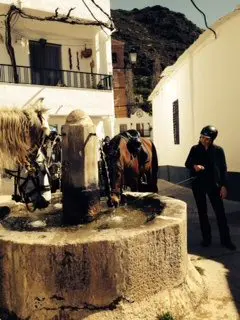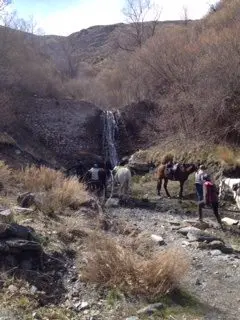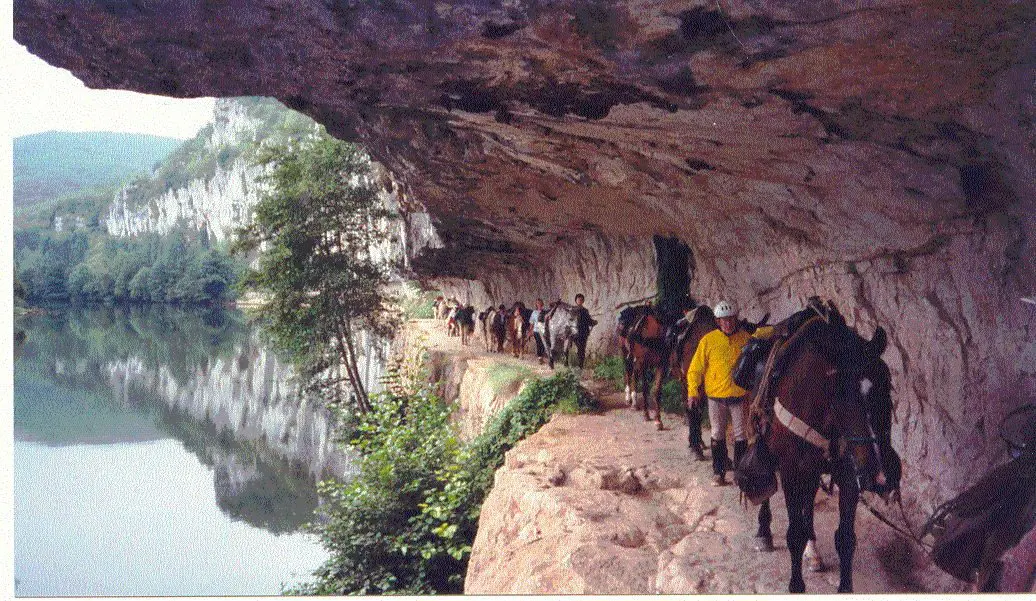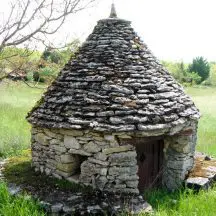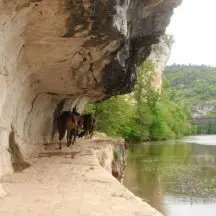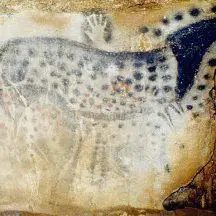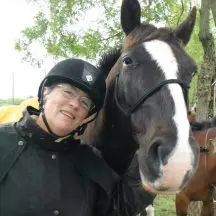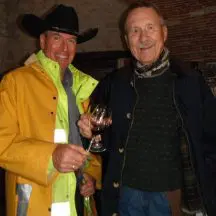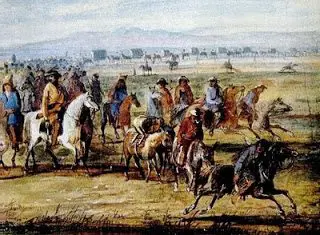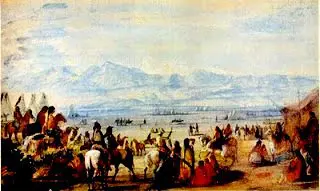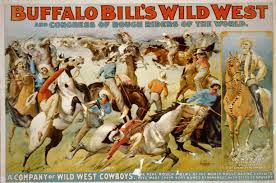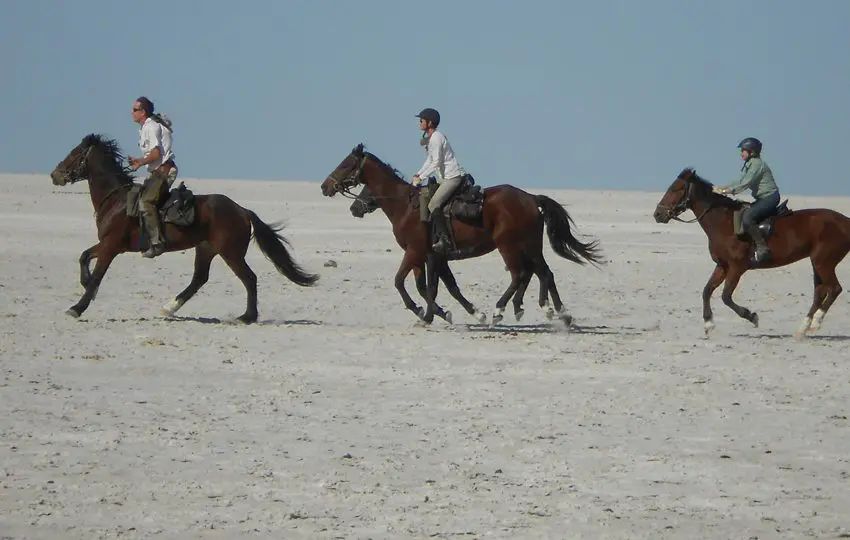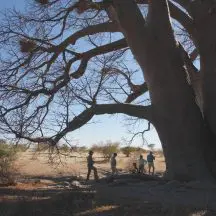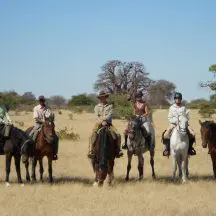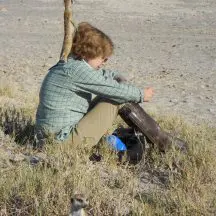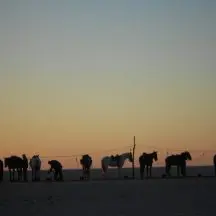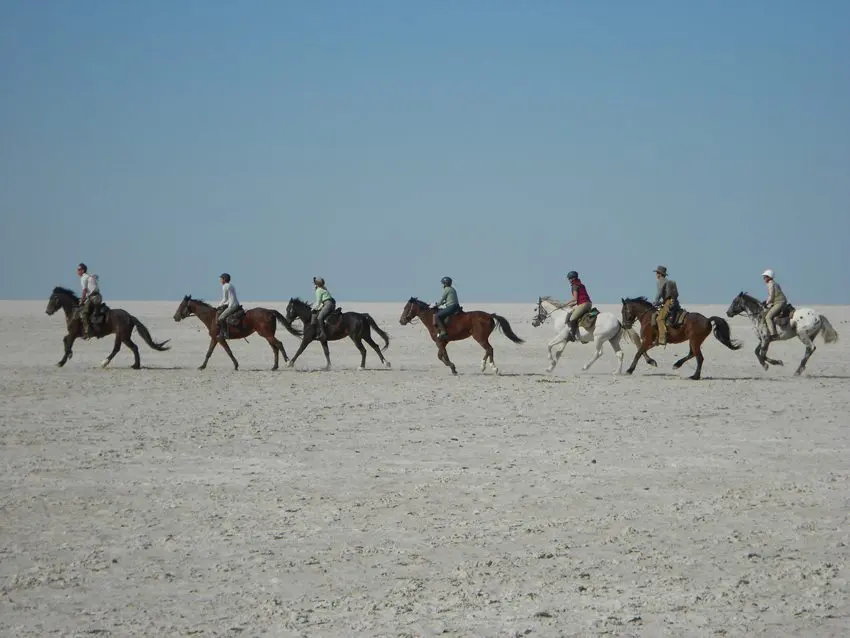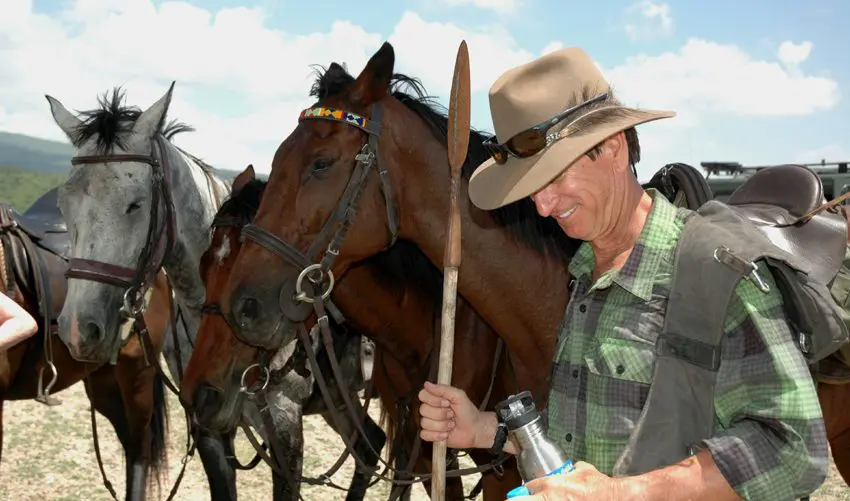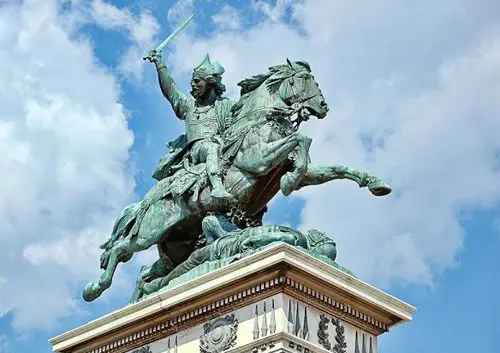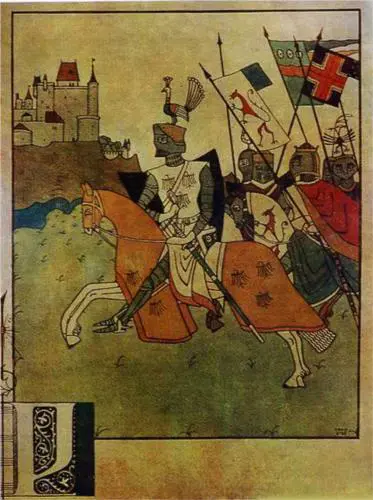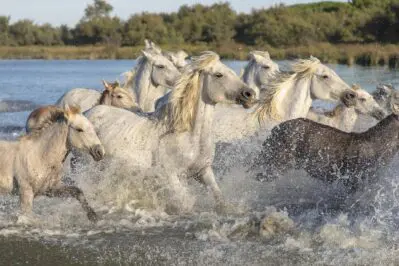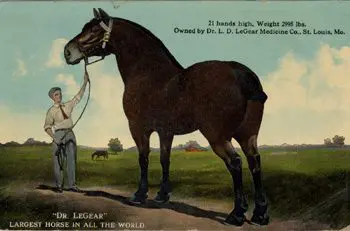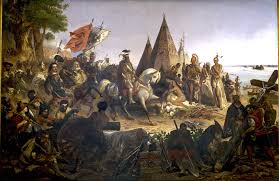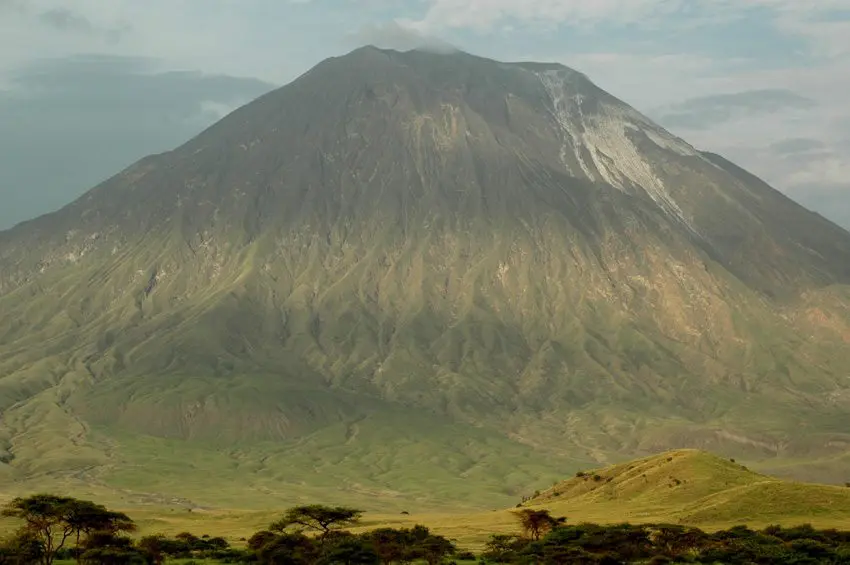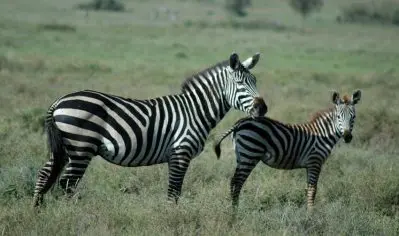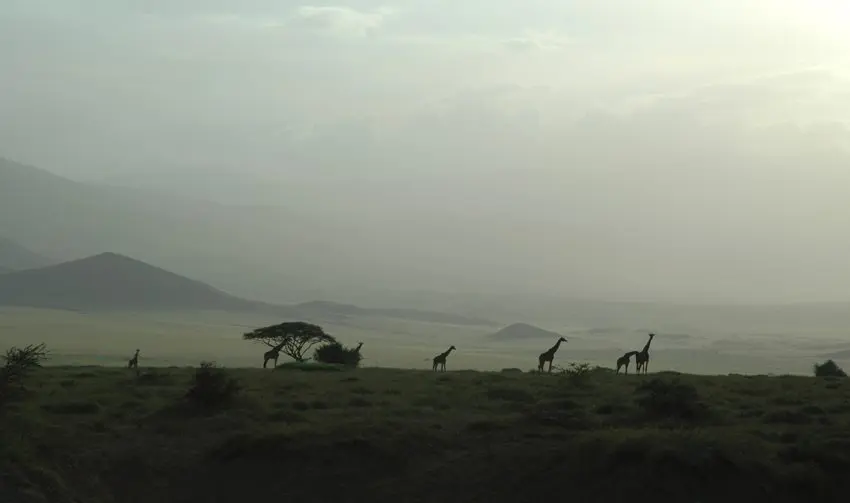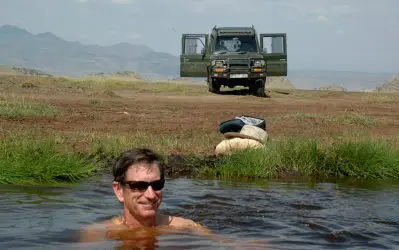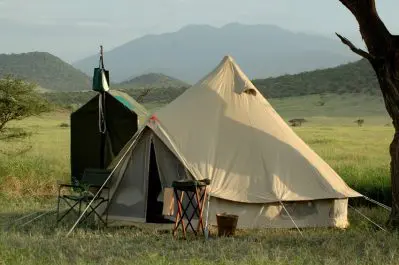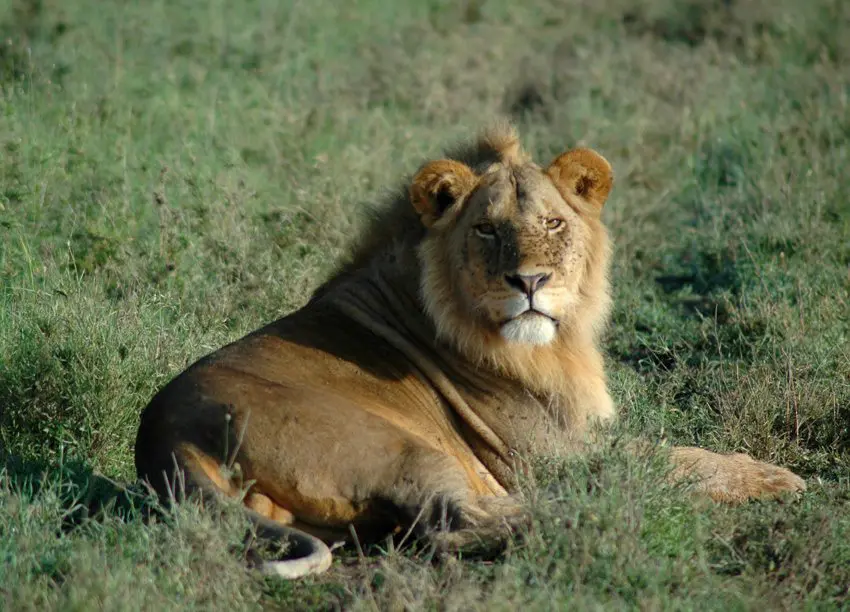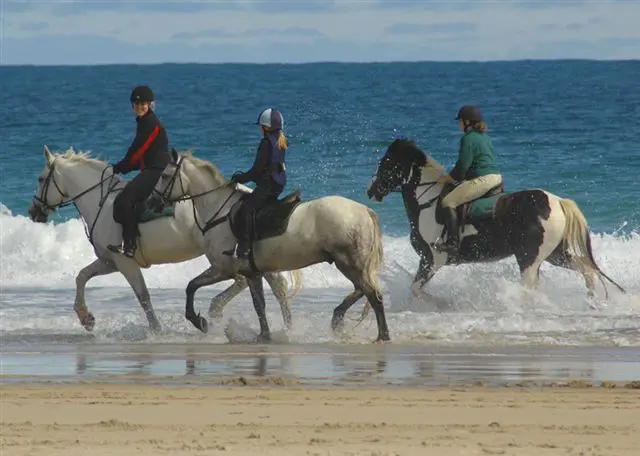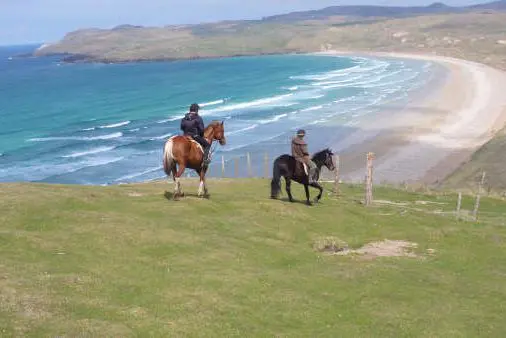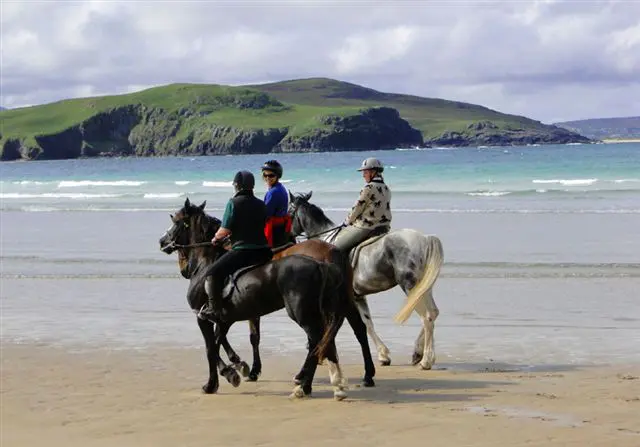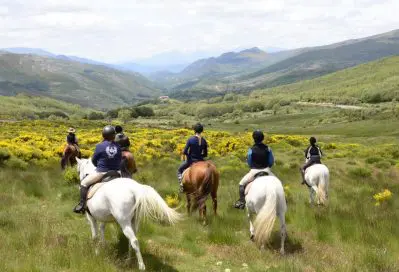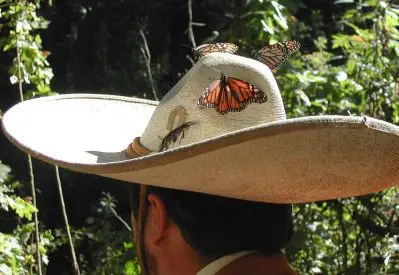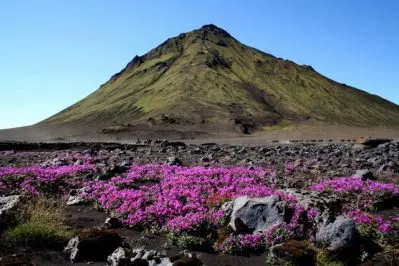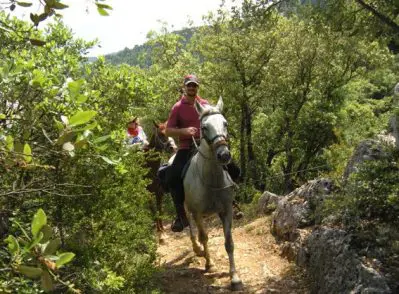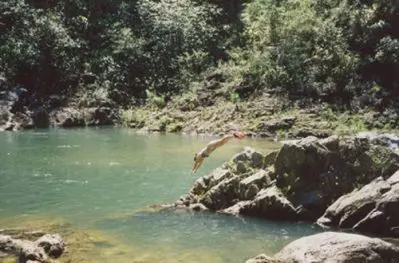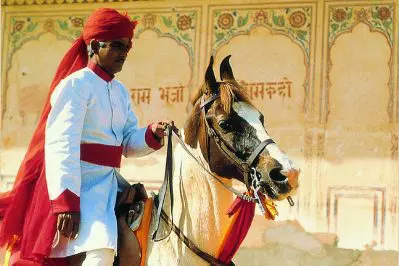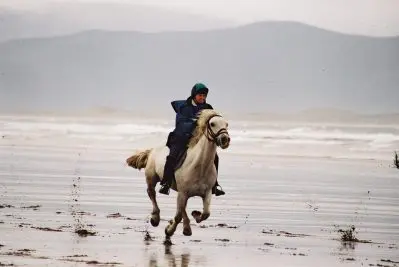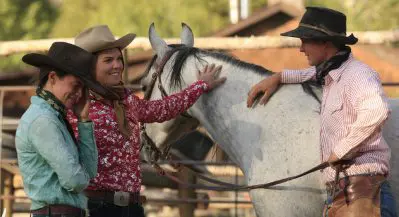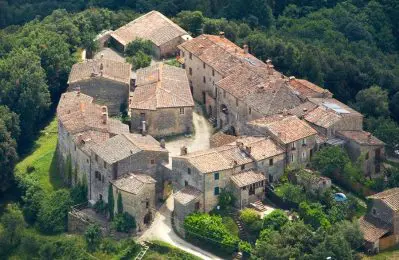A Tough Act to Follow
Below, George Richardson shares the journal of his experience on the Lake Natron Safari. Please also see his reactions to his second Tanzanian trip in 2016.

Day 1:”Assembly”
Departed Amsterdam for the KLM flight to KIA Tanzania. Met Ginna in the departure lounge prior to the 8 1/2 hour flight. Kathy and Hannah were also on board. After long immigration and visa lines we met one another and our guide. I was dropped off at KIA Lodge while they proceeded to Shangazi House near Arusha.
Mel and Amy are in Nairobi and Barbara is on Precision AIR from Nairobi. Maryellen is desperately trying to extend her passport to fly in tomorrow night. No doubt it will all come together though it seems a bit scattered at present.
Check into KIA Lodge and take in the familiar sounds and smells of East Africa. It feels great to be back.
Day 2: “R and R (Rays and Reptiles)”
Pretty day! Clear and sunny; a pleasant change from the cold and wet Virginia weather. Sat by the pool with a view of snowcapped Kilimanjaro basking in the warmth of the sun. Took a taxi ride to Shangazi House to meet up with my fellow riders. Upon arrival I was met by Mario the warthog and his or her private keeper. Shangazi House lies in the shadow of Mount Meru with several very attractive cottages situated around the main residence. We walked the grounds visiting the flower and vegetable gardens and sat by its pool. Kilamanjaro seems to edge Safari in the local brew taste test. Nicoise Salad for lunch. The passion fruit sorbet gets the nod over the tamarind.
Vincent led Kathy, Hannah and me for a walkabout to the Snake Museum at 4 pm. We trod past the poultry houses and a rousing soccer game and then up the road through a small village. As we approached the entrance to Arusha National Park we saw the Reptile Sign and were met by our tour guide. He was proud to show off their venomous and non-venomous snakes, muscular monitor lizards, chameleons, leopard tortoises and turtles, allowing us to handle many of the harmless specimens.
(As it later turned out we didn’t see a single snake on safari other than a small one being carried off by a raptor. Our naturalist guide Chris Rogers was an enthusiastic herpetologist with a charming story of how he surprised Jo with “snake in the bag”.) Our walk lasted about two hours – it was good to stretch after sitting on planes the last few days.
Mel, Amy, Barbara, and Jo arrive for dinner and as dessert is being served, here comes Maryellen. Apparently she makes her plane with less than an hour to spare thanks to the US Passport Agency’s computer freeze. All’s well that ends well.
Day 3 :”Horses and Hosts”
Depart Shangazi House around 9 AM after pumping up and changing a few tires on our two vehicles. We drive to Arusha to find Mel’s luggage – Precision Air is notorious for relieving passengers of their bags – our driver is Steven. After tracking down the required receipt we are out of the city at last and on our way to the first camp to meet the staff and our horses. Along the way we noticed how green the recent rains have colored the landscape. We see our first game: giraffe, lilac- breasted roller, zebra, goshawk and secretary bird. Vehicle # 1 saw a gerenuk.
We arrive in camp around 3 pm and meet a huge staff too numerous to remember all their names. Of course we are introduced to Jo’s partner Chris and Mark the chef.
Our brand new dome tents are arranged along the bank of a dry creek bed with a view of Longido and the plains to the east. There are scatterings of trees to make it a beautiful camp. The horses are picketed just beyond us. There are several showers and loos set up as well as the main dining tent. Behind the dining tent are the kitchen and staff quarters. A quick lunch precedes our introduction ride.
I draw a nice chestnut gelding “Phoenix” a.k.a. Warhorse. Good strong walk, comfortable and fit: perfect.
A very nice two hour orientation to get used to our tack and mounts, long walk with a few trots and canters. We see lots of game on horseback: wildebeest, zebra, gazelle (Grants gazelle and Thompson’s), kori bastards, ostrich and white – back vultures. Beer and biltong by the fire – the first of many good dinners by Mark and a near full moon to cap off the day. Settle in with Hyena whoops and night jar alarms.
Day 4: “Pick up the pace a little”
After breakfast we mount up for a full day’s ride around our camp. We see Grants and Tommies, giraffe, zebra, wildebeest, Masai donkeys, eland and gerunuk. We find a leopard tortoise at our lunch spot. The weather, though warm, has been good. Our horses and we sit out the heat of the day and enjoy a siesta. Most are reading. Kathy is knitting socks and Maryellen is doing needlepoint. We remount in the late afternoon for a ride back to camp.
The light is gorgeous at this time of day. White throated bee-eaters, a European roller and grey hornbill are on the wing and we jump a scrub hare. Another great dinner and beautiful night sky. Unfortunately the Southern Cross is not visible in the January sky unless we wish to get up at 4 AM for a partial glimpse. We will be taking down the camp tomorrow and moving northward in the direction of Lake Natron. Our ride today has been moderate to acclimate us with longer trots and a few more canters – Joanna exhorts us with her pleas to pick up the pace.
Day 5: “Hold the Line”
Light breakfast of yogurt and juice and toast even though eggs and bacon and sausage are offered every morning. Very nice morning ride taking us to waterholes not only used by the Masai livestock but the game as well. There we saw sacred Ibis, spoonbills, stilts, sandpiper, and black-headed heron and 2 crowned cranes. Lots of plains game and Masai cattle, sheep, goats and donkeys with their herdsmen in attendance. Two good gallops chasing wildebeest in vain. Joanna does her best to control her guests with orders to hold the line. Barbara’s mare seems to gravitate towards her pal Phoenix and I can hear her coming; snorting at the canter (Ashberg- not Barbara!)
We draw close to Oldongo Lengai, the only active volcano in Tanzania. Her slopes are dusted with recent white ash. Chris tells us we may hear her rumble during the week. Thankfully we do not. Just prior to lunch we crest a hill and ride next to the rim of a crater. Here we stop for lunch and siesta. The Masai women are waiting for us with their bead work and other crafts for sale. A shopping frenzy is well underway.
I decided to hike down to the crater floor. I am surprised to pick up a breeze most of the way down. Once at the bottom the air is still and very hot. Pied crows fly overhead. Spot a beautiful sunbird with orange and yellow breast and a green/blue head and back. Afternoon ride takes us along another larger crater and up a knoll for a panoramic view of the steppes around us. We walk our horses down the rocky slope. As we approach the “Out of Africa “camp # 2 we have a nice long gallop in and out of tall grass. As we pull up nine giraffe are walking across the acacias in front of our tents. We have a beautiful view of the volcano to the west and the rising full moon to the east. The Milky Way overhead is a halo on our piece of heaven.
Day 6: “Market Madness”
Strange dreams a.k.a. Malarone moments last night. Another beautiful day. A secretary bird is atop an old nest with its mate foraging on the ground not far away. Great morning ride with many gallops. We saw six eland with two calves in the very tall grass. Good hand gallop alongside giraffe. Surprisingly after we caught up with them they seemed content to let us ride alongside. It was obvious they could pull away anytime they chose. Also had a good run with the wildebeest. Ground was reasonably safe for this kind of riding although you were always one stumble away from a cartwheel.
We watered our horses at a Masai waterhole and offered herdsman “pony rides.” I couldn’t help but notice the Masai women were much braver around the horses than the men and it was usually the youngest men that would ride first breaking the ice for the older guys. They seemed to enjoy it and grinned broadly as we led them around.
A large herd of cattle came into drink joining the donkeys, sheep and goats. One red cow was about to give birth as the calf’s hooves were already exposed. She tried to lay down in the water but was prodded to shore and put down. After some adjusting the Masai pulled a calf and had to jump start it’s breathing with a few good drop – yanks. The black calf held its head up ensuring a happy ending for all.
Chris “forced “me to go another wildebeest chase. As we came into sight of camp we gave a go on some ostrich who I believe were the fastest competitors by far. Nice lunch. We decide to give the horses an afternoon off while we go to the Masai market. We had seen Masai livestock on the march to market most of the morning.
We take the two camp vehicles for the 40-minute drive. Along the dirt track we came across a herd of goats tended by a young boy. Several sets of rams are butting heads like bighorn sheep. As we pass through the herd the goats cascade over a dirt cliff reminding me of lemmings leaping over an edge or perhaps like wildebeest plunging into the Mara River.
The Masai market is packed. Everyone is well dressed with most anything for sale from livestock to foodstuffs to sandals to hardware and yes, even brand-new cowbells. Chris buys a young goat as a dinner guest for the staff. He rides very nicely behind our backseat. On our return we spot 16 giraffe silhouetted against the sunset as well as a lovely herd of zebu cattle with an especially big bull. Lamb for dinner and bed by 10.
Day 7: “Highway of Death “
Today will be our longest ride. We will reach Lake Natron by traveling a dry riverbed as our highway. We will thereby avoid the sharp volcanic rock flows but we need an early start to avoid as much daytime heat as possible. Chris calls for 7 AM departure. We have a very good group with many wonderful qualities. Punctuality isn’t one of them… we depart at 8. It is very hot.
Lots of giraffe and a few wildebeest mixed in. We make our way to the riverbed with good sand footing. We pick up the pace a little with a controlled canter as we enter the canyon. We pulled to a quick halt after rounding a blind curve and surprising a herd of cattle watering at two dismal looking puddles. A few of our horses take a sip but Phoenix won’t touch it. Good sense, that horse.
We break out of the canyon onto a deadly hot stretch. We can see Lake Natron shimmering on the horizon. Long columns of zebra are on the move as well. We stop for lunch and seek shade amongst some trees. Unfortunately several hundred ticks are also under those trees. I have itchy feet so I hike west during siesta to find the river. After 30 minutes out I pull up and retrace my steps back to the others. Turns out I was less than a hundred meters from the river. Had I been on horseback I would’ve been able to see it.
Chris and I watch spirals of white pelicans flying high above us. Thunderstorms to the east finally are cooling us down. We ride out at 4 PM and follow the river until its waters petered out. Onward north until we reach the shores of Lake Natron. Many thousands of flamingos greet us there. Masai women hold up their inventory of trade goods but we are too tired to pay much attention.
After a good view of the lake we head eastward to find our camp. We see wildebeest, zebra and grants gazelle. We dismount and lead our horses over volcanic ground and find two of the Kaskazi vehicles stuck in the mud. The large horse lorry looks hopelessly mired up to the chassis while the water truck is in the process of disconnecting the tank and dumping its water. No showers tonight!
Drinks and dinner. A big windstorm kicks up blowing over the mess tent. Quick work by the staff and guests holding poles, double staking and finally moving a big truck to act as a windbreak saves it from complete collapse. Everyone holds on until the wind subsides. Kathy gets her head poled in the chaos. Hyenas are very close by. Bed at 11 PM. Long hard day means a long hard sleep.
Day 8: “Bathing Beauties”
No ride this morning. Horses and riders have earned a holiday after yesterday’s odyssey. We walk about 40 minutes across the pans to bathe in the “Hot Springs.” We come across a fresh wildebeest kill and several old zebra kills. The Hot Springs turned out to be a very pleasant and refreshing flowing stream. Everyone enjoys a nice sit in the shallow water with their beer in hands while cichlids nibble at our feet. Lots of sun cream is applied as the sun is very strong.
Alongside the banks we see Egyptian geese, sacred Ibis, blacksmith plovers and, of course, lesser and some greater flamingos. The staff stretches a tarp between the two vehicles to provide shade for our picnic on the pans. After lunch it was back to the waters but they were now noticeably much warmer and not near as enjoyable as before. We head back in the late afternoon for those who want to take an evening ride before dinner.
Five of us are led by Joanne. Chris is no longer riding as he is focused on the stuck lorry. In addition to the usual ostrich, grants gazelle, wildebeest and zebra we stumble across “Zonk” – the albino zebra that Chris had spotted during a Christmas ride. We turned back towards camp and out on the pans where I found a Masai spear amongst bones and other flood debris. Its origin can only be speculated but according to Chris it was a spear of an older type and I was pretty lucky to find it. We saw jackals close to the fresh wildebeest kill and a hyena on his way to finish it up.
A big wind storm comes up again during dinner taking down the big mess tent. No saving it this time. We evacuate to our dome tents and listen to the rainstorm that follows. The water truck is out and showers have returned but despite all their efforts the horse lorry is still stuck on the pan.
Day 9: “Stuck in Africa”
Up early for a 7 AM ride but as usual we are ready at eight. Staff had left extra early to work on the Lorry. Joanna leads us on a four-hour circumnavigation of the camp awaiting radio confirmation that the lorry had been freed. Had a good view of an African wildcat. We bought two cowbells from the Masai. They of course had to catch the cattle first to remove the bells. Amy and I had two very fine souvenirs.
We see our first hammerkop and Maribou stork. Our experience with the Masai on this trip has been nothing like encounters I’ve had with the Kenyan Masai near the Mara. Our Tanzanian hosts are a much more traditional and rural than their counterparts north of the border and certainly less westernized. It was a special joy to be to be among such hospitable people.
We return to camp for lunch and hallelujah the lorry is out! We will rest for three hours and leave at 3 PM for our return to the “Out of Africa” campsite using the highway of death as our route. We depart at 3:45. Very hot walk out in the open for the first one and a half hours. Zebra, wildebeest, grants, Tommy’s and ostrich trudge in various directions as we move south. Giraffe and Masai herdsman watch from the banks of the dry riverbed. It has now begun to cool especially when we reach the leeward side of the volcano that is now blocking the setting sun. Longest gallop of the ride…4 km according to Jo’s GPS. It was a blast!
As we enter the canyon a very large troop of olive baboons line both rims and had come to water from the same waterholes Phoenix had ignored two days prior. The canyon was shaded and there was a nice evening light. Hard to believe the difference a few hours here can make. Within view of camp a very large herd of zebra, wildebeest and grants gazelle stream by us. It is 7 pm. We enjoy drinks around the fire and our last horse safari dinner with Mark. Another windstorm comes calling right on cue with a light rain to boot.
Day 10: “Equiperils”
Windstorms – flaming heat – stuck vehicles – what a week! Wouldn’t change a single moment of our adventure.
After breakfast we say goodbye to the staff taking photos and presenting our gratuity. We are wearing our napkin – ring bracelets as a remembrance of their many kindnesses. We will take our last ride (2 1/2 hours) from camp directly to the airstrip for a flight to the Serengeti.
We got a late start and try to make up time with some very long trots and canter. We follow the same dirt track that took us to the Masai market. We water our horses at the village trough and carry on to the airstrip. We begin a canter along a heavily rutted stretch that is probably the poorest footing to date for speed. Maryellen’s horse runs up on another and she ends up on taking a dirt nap. Other than a bruise or two and a scrape under the chin she is game and good to go.
As we reach the airstrip the race is on to meet the plane at the opposite end; an exhilarating and climactic finish. We meet our pilot Roland who is a good friend of Chris and Joanna. We celebrate with champagne and photos and then say goodbye to the grooms who will ride our horses back to camp for several days of good grass and long rests.
“Serengeti – bound”: The flight takes 45 minutes. We see our former campsites, fly over Lake Natron and find the migration from above. After landing we immediately noticed the difference in temperature. Due to the elevation we now enjoy cool windy weather with a threat of rain. It is obvious there has been lots of rain here which means good grass and great game viewing. Two vehicles meet us for our first game drive to camp. We see dik-dik, giraffes, zebras, wildebeest, waterbuck, tawny eagle, lappet- face vulture and a pair of jackals and lilac breasted roller.
Vehicle #2 driven by Jo gets stuck on the plains. We wait for our rescue vehicle while the tse-tse flies waste no time sampling the newcomers. Welcome drinks greet us at our field camp K/A Kampi Kampi. The new staff is equally friendly and accommodating. “You are welcome.” We now have a late lunch and get ready for a second game drive.
Serengeti National Park has three rules:
1) No night drives
2) Must stay on existing tracks
3) Must stay in vehicles
We were mostly obedient.
This evening we encountered dik-dik, cokes hartebeest, zebra, giraffe and a distant lioness on a koppi, rock hyrax, cape buffalo, two bull elephants, black and white belly bustards, a leopardess in a tree! We get stuck again. Getting out to push the vehicle in reverse Barbara positions herself directly in front of the right tire and gets slimed with Serengeti sludge. Dinner and bed. The Lions are roaring and the hyenas are whooping. Tomorrow will be terrific.
Day 11: “Migration”
The sun is out and maybe the ground will dry out today. We are told it is unusual for these early rains. Chris’s game plan is to find the migration. As we leave Kampi-Kampi, we note nesting pairs of secretary birds and lappet-faced vultures, zebra, three black-backed jackal and giraffe. It is a cool clear windy morning. We come across courting ostriches and a huge clan of hyena perhaps 40 to 60 strong. Then four eland, three bat-eared foxes, a Montague’s harrier, Egyptian geese, Grants gazelle and a European roller.
Vehicle # 2 flushes another bat-eared fox, which is immediately chased by the jackals. She bristles her tail and thwarts the threat. In addition to his vast knowledge Chris is an incredible spotter. He finds a cheetah on a Thompson’s fawn kill. We are up close and can hear the crunching of bone as she finishes her meal. Lappet-faced vultures and jackals await their turn. Two Tommy mothers stamp their feet and snort vainly for a fawn that will not return.
Because the cheetah is slightly lame on her right front Chris speculates she just happened upon the fawn hiding in the grass. The cheetah is on the move again but will she catch running prey. Four more timid eland and then Chris puts us on two young male lions. We are very close and treated to a long good look at these apparent nomads.
We are still in search of the migration when vehicle # 1 runs into a deep hole. Luckily vehicle # 2 is there to pull us out. An unusual sighting – a rarely seen lion-tailed mongoose (Egyptian mongoose.). Then we see them. Thousands of wildebeest, zebra and gazelles mixed in – a chorus of bleating and short scampers displaying their agility. Barbara accurately describes their bucking behavior as if they had just been stung by bees.
Five more hyena and a pair of black-bellied bustards. Thunderheads are building in the early afternoon. We have our packed lunch on the plains amidst the migration. A male kori bustard is puffed up and in full display to a disinterested prospect. We observed dung beetles make and bury their balls of wildebeest dung. A black-chested snake eagle soars nearby. The wildebeest are on the move again forming long columns as they follow the rains to greener pastures.
We see our first two warthogs – not counting Mario. Sheets of rain are approaching so we must move as well. Chris cuts off the engine so we can hear the sounds of hundreds of hooves splashing along. It makes me sad to think of the great bison migrations that we exterminated in our country. Another lucky find – a serval cat.
As we crossed a stream Chris’s car is stuck again. Two more jackals. Chris’s car cuts off and needs a push to jump start it. Two more warthogs, crowned cranes, buffalo, common reedbuck and Guinea fowl. What a day! Showers and R and R around the fire.
Chris speaks passionately about the needs of the people being balanced with the needs of the wildlife. He’s a strong advocate of both and loves Tanzania. His father was a national park superintendent and counseled Chris on this very subject. Chris and Jo make a great team: engaging and enthusiastic. They revel in sharing the best their country has to offer us.
Day 12: “Hold On” says “the Lion King”
Up extra early at 6 for a 6:30 Game drive. Spectacular sunrise on the Serengeti. First up four bat-eared foxes and then Chris spots a lone lioness in the grass. We approached by vehicle and get a good look. Although not the pride patriarch a magnificent male presents himself as well. He is on a mission and with little apparent effort covers an amazing amount of ground. Hyenas run off as he advances their way. He stops along the track to lap rainwater, scratches, marks his territory and strides off in search of the pride.
As we approach the koppies we see buffalo and rock hyrax. The animators from Walt Disney Studios were sent to this area to draw backgrounds for the film “Lion King”. These islands of piled rock don’t look real but they are every bit striking.
Chris is determined to find us black rhino. There are perhaps 20 or 30 left on the Serengeti. A cow/calf pair were poached just a month ago despite the park rangers protection. Chris finds fresh rhino scat and spoor but no rhino. In addition to yellow billed oxpeckers we find a wattled starling grooming the buffalo and giraffe for parasites. We watch a band of dwarf mongoose sunning on a rock and shortly afterwards a black shouldered kite. Chris heard a slate colored bou-bou; he considers audio just as important as video.
Reedbuck, ostrich and warthog present themselves. Chris picks up a tawny speck on a distant koppi which turns out to be four fully grown male lions in their prime. (Vehicle no. 2 ups the number to 5 by locating an unseen male on the backside.) The lions are enjoying the cool breeze to avoid the flies and of course to watch prey come and go. Palm swifts, a bateleur eagle, an augur buzzard and a northern white crowned shrike are added to the bird list.
We exit our vehicles and breakfast on Ngong Rock. A “hollow” rock is perched on this koppi and when struck with a rock makes a metallic gong-like sound. One can only imagine hours of music played on this ancient instrument. Red and blue agama lizards skitter about. We use binoculars to watch a breeding herd of approximately 20 elephant. Euphobia candelabra adorns our koppi. Mel finds her mother’s favorite flower; a red and yellow lily whose name escapes me now.
We pack up and carry-on. Fisher’s sparrow-larks flee the wheels of our vehicles at the very last moment. We become stuck again twice. It is important to note that our very skilled driver Chris is performing three roles simultaneously: driving under adverse road conditions, spotting game, and overseeing our safety with numerous “hold-ons!” If he is embarrassed he certainly shouldn’t be. We are damn lucky to have him.
Another leopard! A clear view of a leopard climbing up a koppi boulder. Fantastic. A long crested snake eagle is perched on an acacia just 50 meters away. Now we are amongst the breeding herd of ellies. A large cow with enormous tusks is identified by Chris as the same one that charged the vehicle in December. We give her a wide berth. We note one elephant is missing the lower portion of her trunk no doubt due to a snare.
Somehow Chris notices a shiny back that seems out of place with the buffalo we are watching. It is a hippo: not the best view but a sighting nonetheless. We crossed a man-made dam and park at a small impoundment. Impala and banded mongoose were seen on the way in. Chris pointed out a Fischer’s lovebird and lilac-breasted rollers in the thorn bush and a pintail wydah in flight. Its long tail was twice as long as his body length.
Chris the Lion King strikes again! He locates a lioness who is asleep and straddling a large limb of a sausage tree. We watch her for a very long time twitching, scratching, yawning and readjusting her sleep position. We decide to go back to camp for lunch with plans to return here at dusk.
We get stuck in the mud twice again crossing the stream. It is now getting comical and we are greatly enjoying the increasing rescue count. We lunch and rest before game drive #2.
On the way back to the sausage tree we spot a white-headed buffalo weaver. Upon arrival we note our lionesses has moved from one limb to another. We watch and wait for sunset as Chris is sure she will come down if we are patient. After an hour or so our patience is rewarded. She has noticed a reedbuck but is more interested in the zebra that are moving closer to the stream. After many false starts she finally comes down and is immediately on the stalk of the three zebras closest to the water. She slinks closer as we watch intently. The zebra inexplicably wander away from the ambush.
The light gives way and we must return to camp before dark. A great experience to closely witness this behavior. We wonder whether she was ultimately successful with the zebra.
Tonight’s dinner is our farewell feast at Kampi-Kampi. Where did the time go? Why do we have to leave? After toasting Tanzania and our host, the staff performs their Kampi-Kampi dance with great gusto parading around the table laughing and singing as they carried their goodbye cake. A curious circus of various insects performed on our table between the lanterns. Praying mantis, walking sticks and rhino beetles were the headliners. Perhaps it was time to get out of the bush!
Day 13: “Farewell to Friends”
It is our last sunrise on the Serengeti but hopefully not the last one ever. After breakfast Ginna presents the gratuity from our group. The staff sings songs in our honor featuring a solo by Edison. We say goodbye to Kampi-Kampi and game drive our way back to the airstrip where our pilot Roland will be waiting.
Our Lion King Chris finds lion immediately not 500 m from camp; four lionesses and one large male disappear in an island of thick brush. We later see a black-bellied bustard display his neck craning dance. We add klipspringer to our mammal list. One was atop a rock with its mate standing just below. A huge parade of impala bound by, perhaps 70–80 females with their young herded by a single ram.
Our first vervet monkeys make their debut and two more jackals. Chris shows us the red and black stipple ants that form nests in the whistling thorn acacias. He explains the symbiotic relationship between the ants, the acacia, and browsers. We stop and watch 4 jackals at play chasing one another in a series of tag. Our vehicles push on passing tawny eagle, a bachelor herd of impala, giraffe, slender tailed mongoose, warthog, African brown parrot and cape buffalo.
Chris scans the plains with his bino’s hoping to find another cheetah. Instead he spots a large male lion on a fresh zebra kill. As we zigzag towards him we find a leopard tortoise (its only predator is the ground hornbill), and another bat-eared fox. The male lion is now up and is dragging the carcass and is exerting his full strength to the task. He drags for about 30 seconds before he stops to rest and start again. We now notice there is a lioness at the shade tree we had not seen earlier. Most likely she was the one who made the kill. In any event the male is determined to move the kill away from prying eyes above or below.
We are now a bit behind schedule as we race onto the airstrip. We flush out arctic terns en route. Roland and his boss greet us without a hint of concern about the time. Their plane is all ours. We have a beer before Chris demonstrates Kathy’s protective vest, which she has diligently worn throughout the safari. He attaches himself to the vehicles roll bar and jumps out. The carbon dioxide canisters go off as designed and he safely lands harmlessly on the ground. His neck and organs are cushioned by the inflated pockets covering the vital regions – good show!
On our flight back to KIA Roland takes us over the Ngorongoro Crater. I count at least 11 tourist packed vehicles within a few miles of road. It was high noon – what would the traffic be like at dawn or dusk? It reaffirmed our conviction that we had been treated to a rare glimpse of Tanzania without the human hordes.
Barbara leaves us at KIA and she will fly to Nairobi on Precision Air. She gives instructions to pursue the elusive white beaded belt she coveted from the Masai. She promises me a set of her photos (and Chris’s) in exchange for a game list and a copy of this journal – deal!
We turn around and fly 10 minutes back to Arusha airport. We eat box lunches in the airport lounge before saying goodbye to Amy. She is traveling on to Zanzibar to enjoy the beaches and discover Stone Town.
Steven drives us into Arusha to shop at the Masai market. I find two more cowbells, which I purchased for less than I paid on the trek. No matter; the memories are far more valuable. Chris hops on a motorcycle and goes to the hardware store to buy a six-foot length of PVC pipe, which we supplement with cardboard, plastic sprite Bottle caps and duct tape to ship my spear home.
Chris and Joanna bid us farewell as we leave the market. They must be exhausted after working so hard on our behalf. Certainly we wish them every success together.
Mel and Ginna kindly invite us to the Rivertree Hotel in Arusha where they are staying for an extra two days. We have afternoon drinks under the large shade trees and are treated to pre-flight showers that our fellow passengers will surely appreciate. After a quick dinner of salad and pizza we take our leave for KIA departure on KLM. As Kathy notes we are now “Four Little Indians.”
To get to Amsterdam one naturally has to fly to Dar es Salaam first. This way you can add an additional three hours to the flight. I invite a Tylenol p.m. to the party and we enjoy a seven hour sleep over.
We arrive in Amsterdam and experience the forgotten shock of cold air. Hannah is off for home. She will be seeing patients first thing in the morning. Goodbye hug and now there are three. Coffees, juice and pastries and some idle shopping. We visit the art museum located within the terminal. Can’t speak for the others but I’m hitting the wall. Maryellen and Kathy’s flight to JFK leaves first – the final farewell – now is just me and a ticket to Washington – Dulles.
Future plans within our group were being bandied about including travels to Iceland, Turkey, Chile and Turkmenistan. This trip is a tough act to follow.
Ride Review by George Richardson


